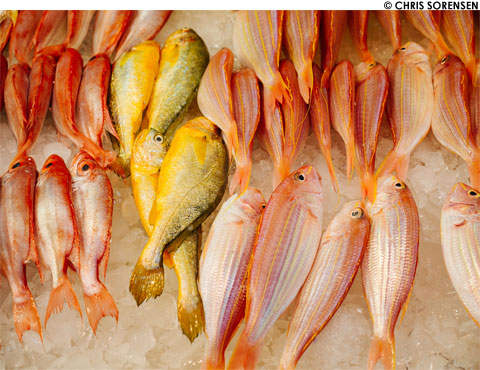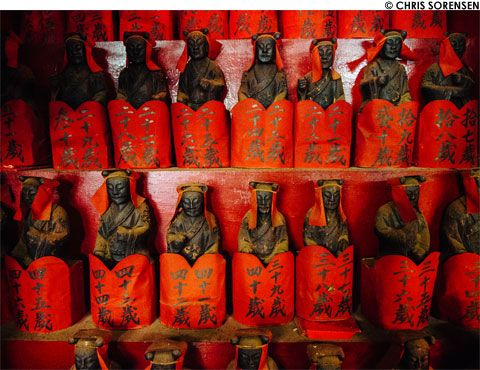
Fish vendor's stand in Wan Chai |
THIRD COURSE: SEA MANTIS AND SQUID, SWEET TEA BUNS
If you take the subway one stop beyond Disneyland Hong Kong, you will arrive at the launch point for a gondola that will take you to Ngong Ping 360 on Lantau Island, where the 111-foot-tall Tian Tan Buddha sits on a mountaintop. This is where I learn that Jamie is terrified of heights.
The gondola is a contraption like a clear, enclosed ski lift, and it is Jamie's worst nightmare. For the entirety of the ride — 25 minutes of lush coastal views as we scale the mountainsides, each dip steeper than the last — he sits with his hands clasped over his knees, looking straight ahead, breathing meditatively.
The island turns out to be a cartoonish theme park of spirituality. The giant Buddha towers over crowds of tourists toting souvenir bags, and an insidiously horrible jingle for Ngong Ping 360 blasts, on a loop, from speakers lining the streets. As we climb the 268 steps to the Buddha, Jamie tells me that he still meditates every day, a habit he's had since his 20s.
"Being straight edge, I lived clean," he tells me later. "Some straight-edge bands were talking about Hare Krishna and Krishna consciousness. I was lost, angry, and needed something." He tried Buddhism, went to a Congregationalist youth group with friends, bought a copy of the Bhagavad Gita — one of the cornerstone texts of the Hare Krishna belief system — and researched the seven purposes of the Hare Krishna faith. He never considered himself a devotee, but he fell in love with the idea of meditation and clarity of thought. He says he wasn't good at it.
"I loved something about Eastern religion, and I liked the free food on Wednesdays at the Krishna temple in East Hartford," he says. "I tried to mimic the Indian curries at home. It was my go-to when I lived in Florida and wanted to cook for my roommates, when we had a combined four dollars in change."
After a quick vegetarian lunch at the monastery, where Buddhist chants echo through the courtyard, Fred hails a cab, and we drive away from the fray, up into a quiet pocket of the mountains. We arrive at another temple, silent and empty. "This is what I'm talking about," Jamie whispers as we slip out of our shoes at the entrance. He takes a moment alone on the balcony, his silhouette framed by nothing but green on all sides.
Inside, we pad silently in our socks up a few flights of shiny wooden stairs to find the Hall of Ten Thousand Buddhas. It's not an exaggeration: the ceiling, round and spiraling upward, is lined with ten thousand gold-painted wooden Buddha statues, all a few inches high. We're alone in the room, and the effect is breathtaking, as is the view of the valley out the windows — the haze softening the glare of the sun.

Figures inside a Wan Chai temple |
Adequately humbled, we pack back into the cab and zip down narrow roads lined with lush greenery toward tiny fishing village Tai O on the northwestern coast of Lantau. Jamie names all the edible plants on the hillsides as they blur past us.
Fifteen minutes later, we walk straight into a wall of pungently fishy air. A pack of Western tourists troop by, and a woman in a pastel polo and diamonds presses her scarf to her nose and mouth. Her eyebrows furrow miserably. "God, I love that smell," Jamie says, already starting toward the market. Everywhere you look, there are freshly caught fish lying out on mesh racks, hanging from porches or clotheslines.
All the house foundations — wooden stilts shoved into muddy low-tide waters — are covered with oysters (the non-edible kind, according to Jamie: "If you were to open one of those, you wouldn't know what the fuck you were looking at"). "See?" Fred says, as we pass a waterfront café, "It's the Venice of Hong Kong!" The houses, topped with corrugated metal, lean ever so slightly. "I would live here in a second," Jamie replies.
We pick a direction and walk. In one shop, puffer fish hang from the ceiling like spiky balloons. Across the street, a shark skin taller than I am is tacked against a wall. Behind me, Jamie is perusing a stand of dried goods: mini mountains of shrimp and bay scallops, cashews, sea cucumbers. A vendor disappears into the back and brings him different packets to smell. "I don't know what it is, but I want to take it home and play with it," he says, handing over some bills.
The street food on Tai O is hard to resist: grilled dried sea mantis and squid in a sweet soy sauce with chili oil, roasted over a pit of charcoal in metal grates, arrive in a grease-stained paper bag. The bite-sized pieces are tough as beef jerky, and they light up your mouth as you work them apart with your teeth. Sweet tea buns with peanuts are served warm on lotus leaf, wrapped in white velum paper. The little mounds look like thick globs of gelatin, so darkly green they're almost black. It's impossible to look cool eating them (I find this out instantly, attempting to gnaw at it while Jamie holds it to my face awkwardly). But the sticky texture is perfectly elastic, and the tea lends a subtly sweet earthiness.